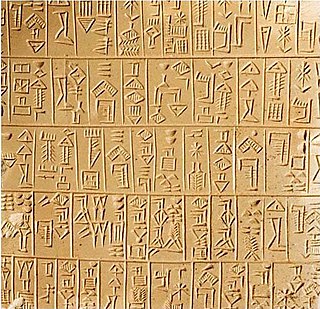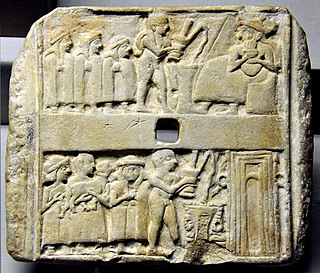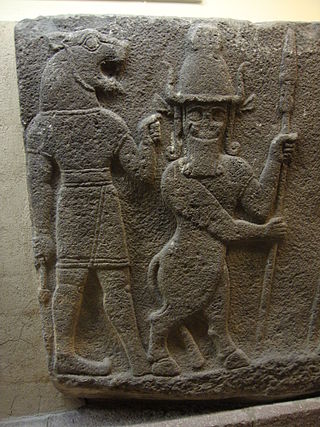Related Research Articles

Enlil, later known as Elil, is an ancient Mesopotamian god associated with wind, air, earth, and storms. He is first attested as the chief deity of the Sumerian pantheon, but he was later worshipped by the Akkadians, Babylonians, Assyrians, and Hurrians. Enlil's primary center of worship was the Ekur temple in the city of Nippur, which was believed to have been built by Enlil himself and was regarded as the "mooring-rope" of heaven and earth. He is also sometimes referred to in Sumerian texts as Nunamnir. According to one Sumerian hymn, Enlil himself was so holy that not even the other gods could look upon him. Enlil rose to prominence during the twenty-fourth century BC with the rise of Nippur. His cult fell into decline after Nippur was sacked by the Elamites in 1230 BC and he was eventually supplanted as the chief god of the Mesopotamian pantheon by the Babylonian national god Marduk.

Ninḫursaĝ sometimes transcribed Ninursag, Ninḫarsag, or Ninḫursaĝa, also known as Damgalnuna or Ninmah, was the ancient Sumerian mother goddess of the mountains, and one of the seven great deities of Sumer. She is known earliest as a nurturing or fertility goddess. Temple hymn sources identify her as the "true and great lady of heaven" and kings of Lagash were "nourished by Ninhursag's milk". She is the tutelary deity to several Sumerian leaders.

In Sumerian and ancient Mesopotamian religion, gallûs were great demons or devils of the ancient Mesopotamian Underworld.

Anzû, also known as dZû and Imdugud, is a lesser divinity or monster in several Mesopotamian religions. He was conceived by the pure waters of the Apsu and the wide Earth, or as son of Siris. Anzû was depicted as a massive bird who can breathe fire and water, although Anzû is alternately depicted as a lion-headed eagle.
In Mesopotamian mythology, the Tablet of Destinies was envisaged as a clay tablet inscribed with cuneiform writing, also impressed with cylinder seals, which, as a permanent legal document, conferred upon the god Enlil his supreme authority as ruler of the universe.
Pabilsaĝ or Pabilsag was a Mesopotamian god who was the tutelary deity of the Sumerian city Larak. He is best known as the husband of the medicine goddess Ninisina.

Sumerian literature constitutes the earliest known corpus of recorded literature, including the religious writings and other traditional stories maintained by the Sumerian civilization and largely preserved by the later Akkadian and Babylonian empires. These records were written in the Sumerian language in the 18th and 17th Centuries BC during the Middle Bronze Age.

Sumerian religion was the religion practiced by the people of Sumer, the first literate civilization of ancient Mesopotamia. The Sumerians regarded their divinities as responsible for all matters pertaining to the natural and social orders.
The Magilum Boat in Sumerian religion also known as the 'boat of the west' was one of the valuable items seized by Ninurta, patron god of Lagash, in ancient Iraq. This spoil was hung on an unknown part of his chariot according to the ancient source .It is also mentioned in The Epic of Gilgamesh: "All living creatures born of the flesh shall sit at last in the boat of the West, and when it sinks, when the boat of Magilum sinks, they are gone."
The Strong Copper in Sumerian religion was one of the valuable items seized by Ninurta, patron god of Lagash, in ancient Iraq. This spoil was hung "on the inside pole pin" of his chariot according to the ancient source.
The Dragon was one of the warriors slain by Ninurta, patron god of Lagash, in Sumerian religion. Its body was hung on the seat of his chariot according to the ancient source.
Lord Saman-Ana in Sumerian religion was one of the Heroes slain by Ninurta, patron god of Lagash, in ancient Iraq. Almost nothing else is mentioned of this "hero", his appearance is lacking.
The Mermaid in Sumerian religion was one of the Heroes slain by Ninurta, patron god of Lagash, in ancient Iraq. Her body was hung on the foot-board of Ninurta's chariot.
The Seven-headed Serpent in Sumerian religion was one of the Heroes slain by Ninurta, patron god of Lagash, in ancient Iraq. Its body was hung on the "shining cross-beam" of Ninurta's chariot.
The Six-headed Wild Ram in Sumerian religion was one of the Heroes slain by Ninurta, patron god of Lagash, in ancient Iraq. Its body was hung on the dust-guard of Ninurta's chariot.

The Gudea cylinders are a pair of terracotta cylinders dating to circa 2125 BC, on which is written in cuneiform a Sumerian myth called the Building of Ningirsu's temple. The cylinders were made by Gudea, the ruler of Lagash, and were found in 1877 during excavations at Telloh, Iraq and are now displayed in the Louvre in Paris, France. They are the largest cuneiform cylinders yet discovered and contain the longest known text written in the Sumerian language.

Sharur, which means "smasher of thousands" is the weapon and symbol of the god Ninurta. Sumerian mythic sources describe it as an enchanted talking mace. It has been suggested as a possible precursor for similar objects in other mythology such as Arthurian lore.

Kusarikku ("Bull-Man"), sometimes inscribed GUD.DUMU.dUTU, GUD.DUMU.AN.NA and sometimes phonetically ku-sa-rik-ku(m), synonymous with the Sumerian GU4/gud-alim and perhaps also alim (see below for caveat), was an ancient Mesopotamian mythological demon shown in artistic representation from the earliest (late Uruk period) times with the arms, torso and head of a human and the ears, horns and hindquarters of a bull. He is portrayed as walking upright and characterized as a door keeper to protect the inhabitants from malevolent intruders. He is one of the demons which represented mountains. He is pictured in late iconography holding a banduddû, "bucket". On a stela of Meli-Šipak, the land grant to Ḫasardu kudurru, he is pictured carrying a spade.

The work known by its incipit, Angim, "The Return of Ninurta to Nippur", is a rather obsequious 210-line mythological praise poem for the ancient Mesopotamian warrior-god Ninurta, describing his return to Nippur from an expedition to the mountains (KUR), where he boasts of his triumphs against "rebel lands" (KI.BAL), boasting to Enlil in the Ekur, before returning to the Ešumeša temple—to “manifest his authority and kingship.”

Igalim or Igalimma was a Mesopotamian god from the local pantheon of the state of Lagash. He was closely associated with Ningirsu, possibly originating as the personification of the door of his temple, and was regarded as a member of his family. His older brother was Shulshaga and his mother was Bau, as already attested in Early Dynastic sources. Until the end of the Ur III period he was worshiped in Lagash and Girsu, where he had a temple, though he also appears in a number of later texts.